How to stop condensation in a shipping container
The problem: Condensation in containers
The solution: ThoMar container desiccants
Our high-grade container desiccants will help you safely reduce air humidity in your containers and stop condensation from forming in your container, and the associated moisture damage.
Why does condensation form in containers?
During transport and storage, considerable temperature fluctuations occur inside freight containers. This happens not only at ports and railway stations in different climate zones, but when products are stored in containers at a fixed location. Temperature differences of several dozen degrees Celsius can occur between day and night. Since warm or hot air can absorb far more moisture than cold air, a drop in temperature in an airtight, closed freight container results in the formation of condensation in your containers. This results in container sweat, container rain and cargo sweat.
Moisture in the container? No way!
Get telephone advice now!What’s the difference between container rain, cargo sweat, and container sweat?
Condensation in containers manifests itself in various ways, with experts distinguishing between container sweat, container rain, and cargo sweat.

So-called container rain is condensed water that forms on the interior surfaces of the container itself. Due to surface tension, the water accumulates in increasingly large drops, which then fall due to their weight. Container rain then falls directly onto the cargo.
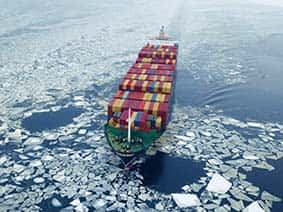
Container sweat usually occurs near the ceiling of the container and is due to a drop in outside temperatures – when the container wall cools sharply during transport in colder regions or at night. as a result of cold ambient air. The moisture is drawn out of the much warmer air in the container, collecting on the container.
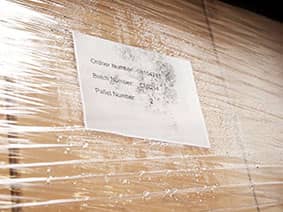
Cargo sweat occurs when goods are transported from a colder to a warmer environment or when the sun warms a sea container that has cooled overnight. Cargo sweat is produced when air inside a container heats up faster than the cargo, causing condensation to form on the surface of the freight, packaging and packaging aids.
Potential damage caused by shipping container condensation
Condensation in containers can damage goods in several ways. Container sweat and cargo sweat can both result in:
- Corrosion and rusting of cargo
- Mould on packaging and goods
- Sodden cardboard
- Detached labels
Container condensation is associated with a high risk of corrosion – for steel cargo components in particular. This applies both to materials being shipped for industrial processing and to finished end products. Condensation in containers needs to be effectively bound and safely controlled to prevent rust forming on cargo, and avoid the possibility of it being destroyed during sea transport.

Condensation in
containers results in rusting of steel cargo.
Preventing the formation of mould during transportation is crucial, particularly in the food industry. If suitable countermeasures aren’t taken, any cargo or container sweat arising at sea will quickly generate a climate in which mould forms on packaging and goods, and swiftly spreads.
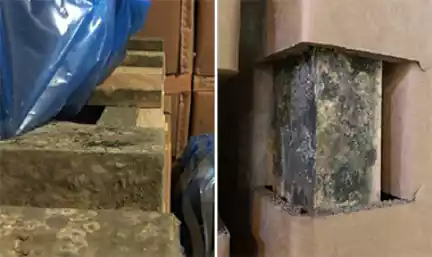
Condensation in containers favours mould formation on packaging and
goods.
Even if a cargo in a freight container cannot rust and is relatively impervious to mould, condensation can still cause extensive damage, making the cargo unusable. When moisture from the ambient air condenses directly onto a cargo, or container rain falls from the container ceiling, it can make cardboard packaging completely sodden and also cause labels to become detached.

Condensation in
the container causes moisture damage to packaging.
Moisture control in containers: Which measures should you take?
There are lots of different conditions that can cause moisture to become a serious problem in containers and cause devastating damage to a cargo. It is necessary that effective and targeted countermeasures are put in place to prevent container condensation...

Step 1: Analysis
Determining the right measures to prevent moisture damage
Preventing the formation of condensation in containers with ThoMar desiccants during transportation depends on a multitude of factors. There are various aspects at play, including the:
- Goods being transported
- Climate zones passed through
- Size of the container
- Weight and moisture content of the goods
- Packaging aids used
- Storage and transport duration, and other parameters.
ThoMar container dehumidification experts will help analyse the individual requirements for your particular use case.
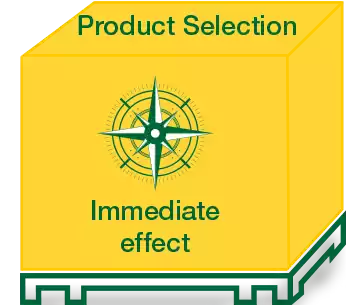
Step 2: Product selection
Avoid shipping container condensation through the effective use of desiccants
The desiccants produced at our facilities in Germany tackle container condensation, and we adhere strictly to the highest standards of product quality and working conditions. The spatial characteristics of a loaded container have to be taken into account to effectively combat container moisture damage. We offer training for customer employees to enable them to select and optimally place the desiccants for their use case.

Step 3: Practical input
Combat condensation in containers
Preventing container condensation involves more than deploying the right amount of suitable desiccant. We offer our customers a genuine all-round service to keep their containers and storage spaces dry, which includes:
- Individual needs analysis,
- Expert advice,
- Desiccant product selection
- Training.
You can also ask us to undertake
- a test series,
- a review of your logistics process
- provide practical assistance for optimal use of desiccants
Our goal is for the moisture control measures you take to be 100% effective.
Made in Germany: Certified quality from the Duchy of Lauenburg (near Hamburg)
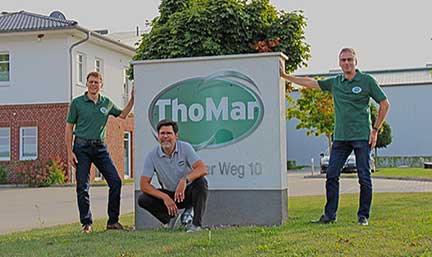
Management ThoMar OHG (from left): Thomas Möller, Daniel Schuback, Martin
Möller
ThoMar OHG has more than 20 years of experience in producing and trading desiccants. We produce our shipping container desiccant exclusively at our German location in the Duchy of Lauenburg at the gates of Hamburg. We take care to observe the highest standards with regard to the contents and sheathing materials, product quality and protection of our employees. We supply industry and the wholesale trade directly ex works. ThoMar OHG has been ISO 9001-certified since 2012 for the development, manufacture and distribution of desiccant bags and air dehumidifiers. Smaller quantities of desiccants can also be ordered in our B2B online shop.











